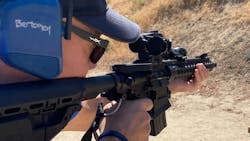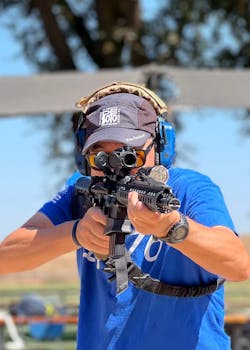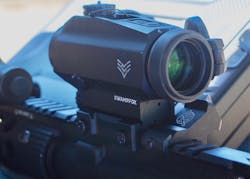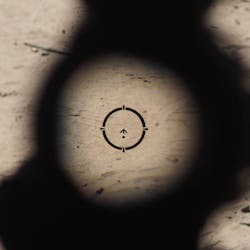Swampfox Blade 1x25 Carbine Optic Review
I got to test the Swampfox Blade 1x25 carbine optic. This test determined that this optic is the ideal tool for patrol carbine use.
The Blade is an etched reticle, illuminated, prismatic optic housed in a 6061-T6 aluminum tube with fully coated optics. It weighs 13.1 ounces, and it has an integral mounting system for Picatinny rails. I tested it on a Lancer L15 AR, with an MMC Armory upper. This combination is an ideal set up for a mid weight carbine. This MMC Armory upper launches accurately out to 400 plus yards.The most obvious advantage for the prismatic design is the fact that, even if the battery fails, the optic will not, because it does not need illumination to produce a reticle image. The crispness of a prismatic image is self evident. When it comes to the fluid engagements of Law Enforcement, we can't be sitting there fiddling with the sights. The answer is to create a duplex reticle that the eye can align quickly, but it has different points of aim. The trick is making the reticle simple enough for snap sighting decisions, and cleverly designed so as to give as much target visibility inside the optic as possible.
Speaking of fluid engagements, there are other serious advantages to an etched reticle. Let's say an Officer is behind cover and has a good sight picture on a suspect in a high risk encounter, but he does not want to give up his position by projecting light. All of a sudden, other units begin to arrive and light up the entire scene with spotlights. With a red dot, this may require illumination adjustment. With an etched reticle, the sighting illumination is washed, and the reticle image returns to black, with no distortion. No adjustment needed.
Rather than making complicated aiming adjustments, the Swampfox Blade is designed for dedicated holds, points of aim on the reticle for different engagements. To tell you the truth, there are enough incremental measuring surfaces in the reticle to even make accurate range estimates.The Blade 1x25 has a center arrow-like pointer, inside a 90 MOA circle. 20 MOA's below the arrow is a 6 MOA dot. Looking through it, I found it was much less complicated than it sounds. The tip of the arrow is for 50 and 100 yard engagements. The 6 MOA dot is for 10 yard engagements, and the truncated cone at the bottom is for close work.
The dot is easy to align for high risk car stops. Using the tip of the arrow and the full field of view for carbine distance engagements is simple. The set up is uncluttered, and the prismatic optics make it crisp at all distances.The down side to prismatic optics varies with the individual product. This design has parallax, so the parallax free range has to be part of the design. The Blade is parallax free out to 100 yards, well within the parameters of its intended use. The other part we have to consider is eye relief. The 3.8" eye relief is too tight if anyone wants to add a magnifier in front of it. The Blade is NV capable, and one power optics are really ideal for the officer who needs to do interior searches and engage past 25-100 yards anyway.
There is a difference between a deliberate deployment carbine, what some would call a long gun configured for team deployment, and a patrol carbine. The patrol carbine is a "grab and go" instrument, called upon to bridge the gap between handgun use, and a next tier response by a pre organized team.
The patrol carbine has to be versatile, and only take a moderate amount of training for proficiency. There are some arguments about whether this carbine should be a LPVO (low powered variable optic), or a 1x optic. Some agencies are politically pressured to even keep the patrol level carbine in "iron sight" mode.
The 1x opic is extremely flexible, and the Swampfox Blade 1x25 is one of the best optics I have seen for this purpose.
LE Officers use AR-15 carbines for various tasks, and Engagement distances vary. In the last few years, it has become common to see an AR 15 used in entry applications.
In the sunlight, we never lit the reticle. Even in bright sunlight the green was easy to pick up in almost any background, but the etched black owned the daylight in the same manner the green owned the night.An etched reticle always has crisper edges, compared to a projected one. Because the image source resides on the focal plane, it doesn't appear to "float" in and out of the image in the tube. That is, some red dot sights have to be "chased" into the sighting plane. This feels more like iron sights in a tube. To me, the eye aligns a prismatic faster than a red dot.
When illuminated, the Blade's reticle has the same crisp edges. I found this was important when moving further out in range. Crisp reticle edges don't just make aiming more accurate, they don't cover up parts of the target the Officer may need to see clearly to make force decisions.
The green illumination (my color choice) pops out and the 10 total illumination positions allow precise adjustments. I personally think that Swampfox could have gotten away with 5 adjustments, but I also miss 3 speed bicycles, when more gear options still prevail. This optic is apparently NV capable, and includes illumination settings for this purpose, which I did not test.
When a bullet leaves the barrel of a gun, it actually rises in an arc-like path, until it succumbs to physics. The sighting plane is not an arc. In most cases, the line of sight intersects the trajectory in two places; at the endpoints of a chord of this arc.
This kind of optic system cannot work correctly unless it has a consistent mounting option. That is, the reticle has to be a certain height off the barrel in order for the bullet rise compensation to work. The Blade comes with its own mount for a Picatinny rail, and it mounts solidly on a carbine. The Blade's mounting system and Bullet Rise Compensating Reticle gives complete compensation for optic height over bore.
When we sight in a gun, we generally pick the most likely distance we will be shooting, and create a coincidence between the line of sight and path of the bullet. If the engagement distance changes, then the strike of the bullet will be different than the line of sight. At the distances one generally engages with an AR-15, the bullet is actually rising from the level of the muzzle.
That Blade comes with prominent windage and elevation turrets that have metal tethered caps. They were obviously designed for field use. Underneath the caps, there is +/- 45 MOA (Minute of Angle) of adjustment, right-to-left, or up-to-down. This translates to 90 MOA of adjustment in .5 MOA increments. It only took me three shots to confirm a zero.
The prismatic system can handle a lot of abuse, and, once sighted, maintained a zero. When I got it running, I experimented with the Shake 'N Wake feature, which preserves the battery. This is almost a moot point, since a single CR123 gives it 3000 hours of use. I did like the Shake 'N Wake, which is kind of like playing with the light on a refrigerator door. I have a Swampfox Sentinel handgun sight, and I can't fool it either. The nice thing about this feature is the fact that it returns to the previous setting when I shoulder the gun.
The Blade is easy to use, and even when turned up to its brightest in a darkened room, it does not have internal reflections typical of red dot sights. There are electronic press switches right over the eyepiece lens for adjustment, and they are easy to click, even when wearing gloves.
Coatings are what make good optics, and the anti fog hydrophobic coatings are also somewhat antireflective. They didn't distort on a sunny day, and their low light usability made this kit worthwhile. This product does come with an ARD cover.
The Blade is water resistant to IPX7 Standards, and it appears to be at home in environmental challenges.
If I had a complaint about this optic, it would be about the flip up lens caps. I couldn't keep them out of the way when I flipped them up. I knocked them off when I bumped something. If I were using this on patrol, I would get a soft neoprene cover, and ditch the lens caps.
The Swampfox Blade is a very complete solution for the patrol level carbine. It comes in red, green, or amber illumination. At $239 MSRP, it is cost effective enough for fleet purchase. It is also an excellent choice for a personal AR-for things that go bump in the night.
About the Author
Lindsey Bertomen is a retired police officer and retired military small arms trainer. He teaches criminal justice at Hartnell College in Salinas, California. He has a BS in Criminal Justice and an MS in Online Teaching and Learning. Lindsey has taught shooting techniques for over a decade. He enjoys competing in shooting sports, running and cycling events.
About the Author

Officer Lindsey Bertomen (ret.), Contributing Editor
Lindsey Bertomen is a retired police officer and retired military small arms trainer. He teaches criminal justice at Hartnell College in Salinas, California, where serves as a POST administrator and firearms instructor. He also teaches civilian firearms classes, enjoys fly fishing, martial arts, and mountain biking. His articles have appeared in print and online for over two decades.




